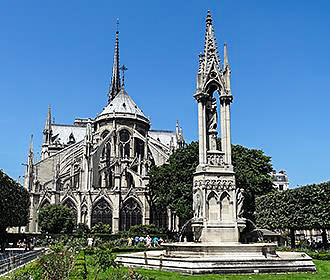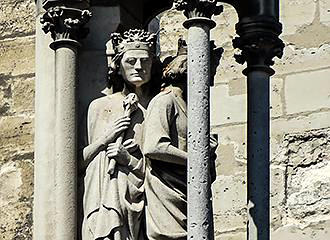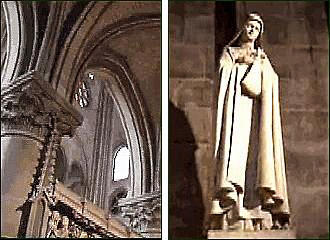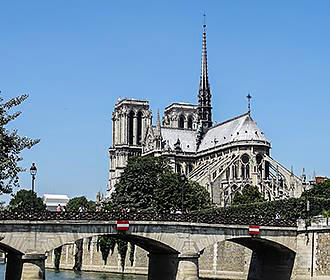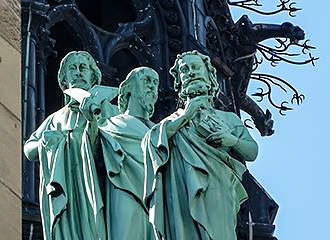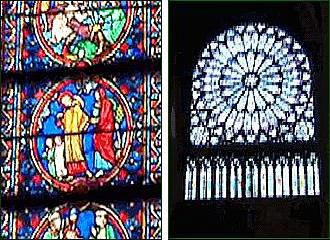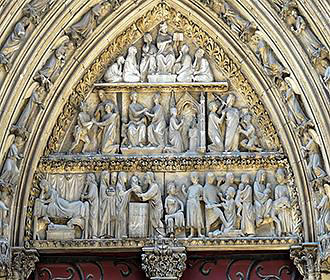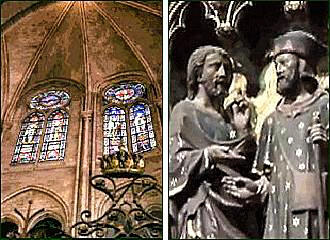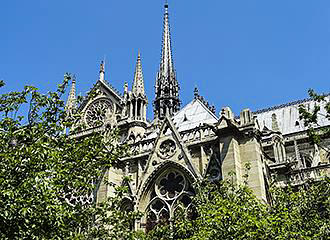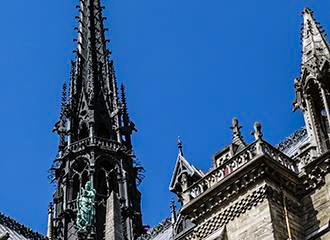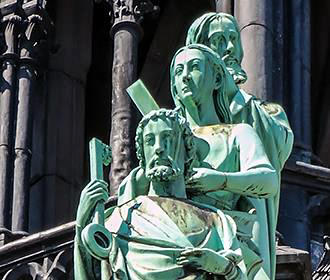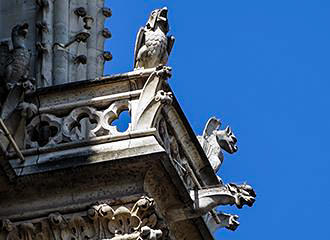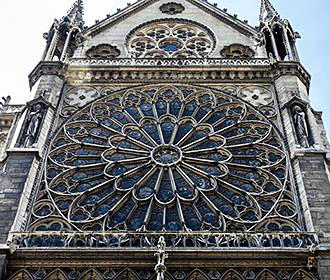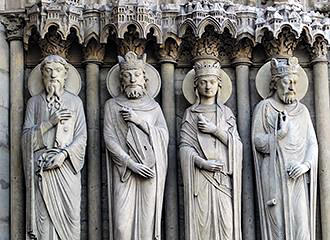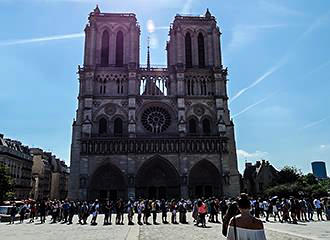Paris Notre Dame Cathedral Facts and Figures
There are around 13 million people who visit the Paris Notre Dame Cathedral every year, which means this is an average of 30,000 people every day, growing to around 50,000 pilgrims and visitors who enter this historical gothic cathedral on peak days.
So whether you are on holiday in Paris as a tourist or on a pilgrimage, this is one of the most popular Paris tourist attractions with the history of the Notre Dame Cathedral being one of the main draws through its size and the medieval architecture.
One astonishing fact is that virtually everyone has heard of the Paris Notre Dame Cathedral, especially since the Hunchback of Notre Dame novel was produced by Victor Hugo, and yet there are so many reasons to visit this famous Paris monument, which is one of the oldest buildings in the city of lights that is still standing.
Paris Notre Dame April 2019 fire
However, as of mid April 2019 when a fire broke out during some major restoration work, unfortunately much of the history has gone to ashes and been lost forever, such as the steeple that succumbed to flames and fell at approximately 7:40pm on 15th April.
Even though some aspects have been lost forever, as you will read further down, much still remains and the history of Notre Dame Cathedral will continue through the rebuilding of this magnificent edifice for future generations to enjoy.
To start with, the Holy Crown of Thorns along with other relics have been held here in the Treasury museum and there was the Veneration on the first Friday of each month for believers, plus there were at least five services or Mass conducted every day and more than 2000 celebrations at the Paris Notre Dame Cathedral every year.
One great fact we can all be happy about is that fortunately these religious relics and artefacts were saved and the religious ceremonies will continue in the future, but lets take a look at some more different fact and events that have taken place along with figures related to the Paris Notre Dame Cathedral.
Facts about Paris Notre Dame Cathedral Building
* The Cathedrale Notre Dame de Paris is often affectionately referred to as The Forest because of the many wooden beams that have been used in its construction, and each of the beams came from a different tree, many of which were around 300 to 400 years old. In fact this building is made up from 1,300 oak trees that represents approximately 21 hectares of forest.
* Technically the gothic arches required sharply sloped roofs and the roof of the cathedral are at a 55 degree incline and during the 11th and 12th centuries church roofs were covered with flat tiles that came from clay deposits. However, there were no clay deposits near to Paris, so lead became the material of choice and the Bishop of Paris, Maurice de Sully willed £5000 to purchase the lead.
* The nave structure supports a lead roof that comprises 1326 tiles that are 5mm thick each and weighs in at 210,000kg.
* The first spire was constructed at the transept crossing, which was a bell tower but was taken down after 1786. Yet during the restoration project overseen by Eugene Viollet-le-Duc, he decided to build a second spire, but not as a bell tower and this was to be independent from the main cathedral structure.
It dominated the Verdigris copper statues of the 12 apostles and being 93m in height it took 500 tons of wood and 250 tons of lead to complete it, but fortunately, when the spire collapsed during the unexpected and tragic fire, the copper apostles had already been removed for restoration work, so they will be replaced at a later date.
* The Western facade is imposing in size that combines harmony and grandeur and at the centre of the facade near the Gallery of the Virgin, there is a large rose window that measures 9.6m in diameter, which was created around 1225.
* The Gallery of Kings statues were destroyed during the French Revolution, however fragments of these were found in 1977 during building works in the Chaussee d’Antin district, which is in the 9th Arrondissement close to the Opera Garnier and Galleries Lafayette. These fragments including some heads are now on display at Musee de Cluny also known as the Musee National du Moyen Age.
* On the lower level of the Western facade there are three portals, but you will find that these are not identical as they were constructed at different times. The central Portal is called the Portal of the Last Judgement and is taller than the other two.
To the right of this or South is the Portal of Saint Anne, which was the first one constructed and to the left or North is the Portal of the Virgin that came next and the middle one was the last portal constructed.
* Paris Notre Dame Cathedrals Western facade has extremely impressive dimensions, as it is 63m to the top of the towers, 43m high up to the base of the towers and 41m wide.
* Also, the Notre Dame Cathedral was one of the first buildings in the world to use the flying buttress system, even though this was not in the original plans and it only ended being designed like this due to lack of stability within the height of the structure, as the walls were bowing outwards.
A interesting fact, you can also take one of the Cathedrals guided tours or enjoy a Tower visit of Notre Dame Cathedral with panoramic views over the Ile de la Cite and Paris, plus get a close up view of the historical gargoyles and the flying buttress system, along with being able to discover more about the gothic architecture and the history of Notre Dame Cathedral.
Facts about Paris Notre Dame Cathedral Organs
* The Great Organ is the largest organ in France and probably the most famous organ in the world that dates from 1401 and although there have been numerous alterations, improvements and changes that expanded it through the centuries, there are still some Medieval pipes that remain.
* Located in the stone loft above the large west portal and under the west rosette, there have been 50 permanent organists so far, although on a Sunday afternoon before the Vespers service, guest organists from all over the world are allowed to play recitals. And one of the first organists was Arnoul Greban who was the famous author of Vrai Mystere de la Passion that started playing at the Notre dame Cathedral in 1450.
* Yet Louis Vierne is probably the most famous organist who originally played at the Saint-Sulpice church in Paris, that was before he was chosen to play on the Great Organ from the year 1900, and he was the first tenured organist at Notre Dame to provide true recitals.
He continued as the main organist right up until his death in the June of 1937, and he actually died at the Great Organ from a massive heart attack whilst performing his 1,750 concert, which was his life long wish.
And you will be able to discover many of his music notes on display at the Musee de Notre Dame museum in Paris.
* After the work initiated by Eugene Viollet-le-Duc and conducted by the famous organ builder Aristide Cavaille-Coll in 1868, the organ became a full symphonic organ with 86 stops on 5 keyboards and a pedal board.
Today, this impressive musical instrument just called the Great Organ of Notre Dame has 56 notes, a 32 note pedal board, 111 registers, the 5 keyboards, 109 ties and an incredible 1,840 pipes, plus was restored in the 1990s to regain the symphonic sounds created by Cavaille-Coll.
* The Choir Organ has two keyboards, one pedal board, 30 ties and 1,840 pipes.
Facts about Paris Notre Dame Cathedral Bells
* The South Tower is home to the grand Emmanuel Bell that dates from the 15th century, which was recast in the year 1681 upon the request of King Louis XIV, who also gave the bell its name. The gand Emmanuel Bell weighs in at 13 tons and is tuned to F Sharp.
But there also used to be a second bell named Marie, yet this was melted down during the French Revolution, however a new drone bell, which again will be named Marie will take its place and ring for the first time 2013.
* The North Tower originally had eight bells, but these were all destroyed during the French Revolution and then during the restoration work that was conducted in the 1800s four new bells were cast, however, again as of 2013 to celebrate 850 years of the cathedral, there will be eight bells at Notre Dame Cathedral in the North Tower, just as there were originally.
Additional Facts about Notre Dame Cathedral
* It was Napoleon Bonaparte I that wanted to save the Paris Notre Dame Cathedral from destruction and he instructed two incredible architects called Jean-Baptiste Lassus and Eugene Viollet-le-Duc to oversee the complete restoration project, however when Jean-Baptiste Lassus died, the entire project was the responsibility of Eugene Viollet-le-Duc.
* In fact, Napoleon Bonaparte I was crowned Emperor in 1804 at the Notre Dame Cathedral by Pope Pius VII, and Napoleon also commissioned a reliquaries, which is a kind of shrine, for the Holy Crown of Thorns.
* Saint Louis, who was also King Louis IX of France, obtained the Holy Crown of Thorns along with other religious relics in 1239 and these were taken to the Notre Dame Cathedral, then placed in the newly constructed Sainte Chapelle chapel, which was the palace chapel on the Ile de la Cite island at the opposite end of the island to where Notre Dame is located.
The Holy Crown of Thorns and the other relics eventually went back to the Notre Dame Cathedral after the French Revolution and were placed in the Treasury, which is where they remained until the tragic events of 2019, where they are temporarily being housed in the Hotel de Ville Paris, having been saved from destruction.
Some events that have taken place at Notre Dame Cathedral
* There have been many celebrations that have taken place at this famous historical monument in Paris over the centuries, including Henry VI of England being crowned King of France in the December of 1431.
* The Dauphin Francois was son of King Henry II of France and he later became King Francois II of France, and he was married to Mary I of Scotland in a ceremony that took place at the Paris Notre Dame Cathedral in the April of 1558.
* Henry Navarre, who later became King Henri IV of France, was married to Marguerite de Valois in a ceremony that took place in the August of 1572.
* Victor Hugo had his famous novel The Hunchback of Notre-Dame published in 1831, which is what sparked interest again in the dilapidated cathedral from the spoils of the French Revolution.
* A major restoration project was put in place under the orders of King Louis Philippe I in 1844, which was headed by architect Eugène Viollet-le-Duc, which was when the new spire was constructed and 12 copper Apostle statues along with the 4 Evangelists were added.

Lasting over 25 years, this restoration project saw many statues replaced and some such as the Chimera being added.
* Pope Pius X beatified Joan of Arc at Notre Dame Cathedral in April 1909, yet she was not canonised until 1920 and is the only figure in history to be condemned and canonised by the Catholic Church.
* The Te Deum has been sung for the coronation of French Kings for many centuries at the Notre Dame Cathedral and a Te Deum Mass also takes place on major events such as to mark the end of conflicts like World War I.
The Te Deum Mass was also performed on 26 August 1944 to celebrate the liberation of Paris, and again at the end of World War II in 1945.
But the Te Deum also accompanies other events in history such as the funerals of the French Heads of State, and other tragedies of humanity that happen such as the Twin towers disaster on September 11th 2001, when people were united through prayer at this historic cathedral.
* The Requiem Mass for the French President General Charles de Gaulle was held on 12th November 1970 and another Requiem Mass for the 21 French President Francois Mitterrand was held in the January of 1996.
* Pope Jean Paul II visited the Paris Notre Dame Cathedral on two separate occasions and the first was in the May of 1980 and he conducted Mass on the Parvis, or square, in front of the this gothic cathedral.
The second visit of Pope Jean Paul II was in 1997 for World Youth Day, but when he died in 2005, believers and followers came in their thousands to pray at this symbolic place. The next head of the church was Pope Benedict XVI and he has also visited the Paris Notre Dame Cathedral as well.
* Towards the end of 2012 and through the majority of 2013, there were exhibitions and monumental moments such as the restored bells all to coincide with celebrations to mark 850 years from when this cathedral was first started to be constructed.
* On the evening of 15th April 2019 one of the most devastating events occurred in the history of events at Notre Dame Cathedral when a fire broke out destroying the spire constructed by Viollet-le-Duc and the roof along with a part of the vaulted ceiling.
Fortunately, much of the structure was saved through the tremendous efforts of fire fighters along with many historical artefacts and priceless items that were retrieved through co-ordinating police efforts from the burning building, which included the renowned Holy Crown of Thorns.
Already undergoing major renovations the 12 copper apostles had been removed prior to the fire, and now over the next 10 to 20 years there will be a complete plan to rebuild the Notre Dame de Paris Cathedrale to its former glory, as confirmed by the French President and the Mayor of Paris.
Dimensions of the Notre Dame Cathedral in Paris
* Notre Dame has a total surface area of 4,800 metres squared, the Paris Notre Dame Cathedral is very impressive and has a length of 128m and the height of the spire is 96 metres.
* The width of the choir is 12m and the length is 36m, and the width of the nave is also 12m, however the height of the nave is a very impressive 60 metres.
* The flying buttresses, which are external supports to stop the walls from bowing or crumbling under the weight of the roof, were started far later than the original construction, with the last ones being added around the apse.
An innovation when they were first installed in the 1200s, some of the flying buttresses were replaced in the 1300s with stronger supports that had a reach of 15m and we have counted 36 of the flying buttress architectural aspect in total.
* The side aisles measure 12m in width and 10m high, however the width of the transept is a staggering 48 metres and is 14m long, yet just as impressive is the West facade, which is an incredible 43 metres in length and is 40 metres wide.
* To finish off these amazing facts on the dimensions of Paris Notre dame Cathedral, we cannot forget to mention that the height under the vault is 33m and the height under the roof is 43 metres.
* Also the height of the towers are 69 metres and there are a total of 380 steps up to the towers, which means this trek would definitely not be for the faint hearted, although the views from above are well worth it!
